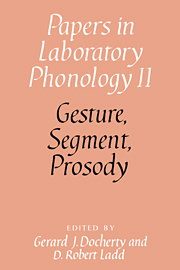Book contents
- Frontmatter
- Contents
- List of contributors
- Acknowledgments
- Introduction
- Section A Gesture
- Section B Segment
- 6 An introduction to feature geometry
- 7 The segment: primitive or derived?
- 8 Modeling assimilation in nonsegmental, rule-free synthesis
- 9 Lexical processing and phonological representation
- 10 The descriptive role of segments: evidence from assimilation
- 11 Psychology and the segment
- 12 Trading relations in the perception of stops and their implications for a phonological theory
- Section C Prosody
- Appendix 1 The test phrases (bold type) of experiment 1 in the context in which they were read
- Appendix 2 The distractors (bold type) of experiment 1 in the context in which they were read
- Appendix 3 The test sentences of experiment 2. The test words are in bold type
- Appendix 4 The distractor sentences of experiment 2. The distractors are in bold type
- References
- Name index
- Subject index
12 - Trading relations in the perception of stops and their implications for a phonological theory
from Section B - Segment
Published online by Cambridge University Press: 18 December 2009
- Frontmatter
- Contents
- List of contributors
- Acknowledgments
- Introduction
- Section A Gesture
- Section B Segment
- 6 An introduction to feature geometry
- 7 The segment: primitive or derived?
- 8 Modeling assimilation in nonsegmental, rule-free synthesis
- 9 Lexical processing and phonological representation
- 10 The descriptive role of segments: evidence from assimilation
- 11 Psychology and the segment
- 12 Trading relations in the perception of stops and their implications for a phonological theory
- Section C Prosody
- Appendix 1 The test phrases (bold type) of experiment 1 in the context in which they were read
- Appendix 2 The distractors (bold type) of experiment 1 in the context in which they were read
- Appendix 3 The test sentences of experiment 2. The test words are in bold type
- Appendix 4 The distractor sentences of experiment 2. The distractors are in bold type
- References
- Name index
- Subject index
Summary
Introduction
All feature sets used in the description of various languages are either phonetically or phonemically motivated. The phonetically motivated features are based on acoustic, articulatory, or physiological facts, whereas phonemically motivated features take into account, for example, the comparability of speech sounds with respect to certain phonemic and/or phonotactic rules. But even if the authors of feature sets agree on the importance of having phonetically adequate features, they disagree on the selection of features to be used in the description of a given speech sample.
This is the situation with the description of Hindi stops. Hindi has a complicated system of four stop classes (voiceless unaspirated, voiceless aspirated, voice, and breathy voiced, traditionally called voiced aspirated) in four places of articulation (labial, dental, retroflex, and velar), plus a full set of four affricates in the palatal region. Since Chomsky and Halle (1968), several feature sets have been put forward in order to account for the complexity of the Hindi stop system (Halle and Stevens 1971; Ladefoged 1971; M. Ohala 1979; Schiefer 1984). The feature sets proposed by these authors have in common that they make use only of physiologically motivated features such as “slack vocal cords” (see table 12.1).
In what follows, we concentrate on the features proposed by Ladefoged, Ohala, and Schiefer. These authors differ not only according to their feature sets but also with respect to the way these features are applied to the stop classes.
- Type
- Chapter
- Information
- Gesture, Segment, Prosody , pp. 296 - 318Publisher: Cambridge University PressPrint publication year: 1992



